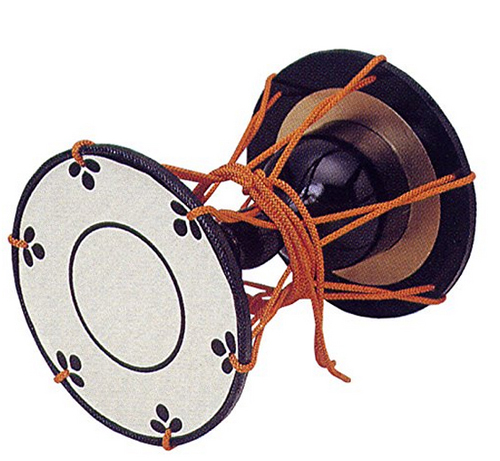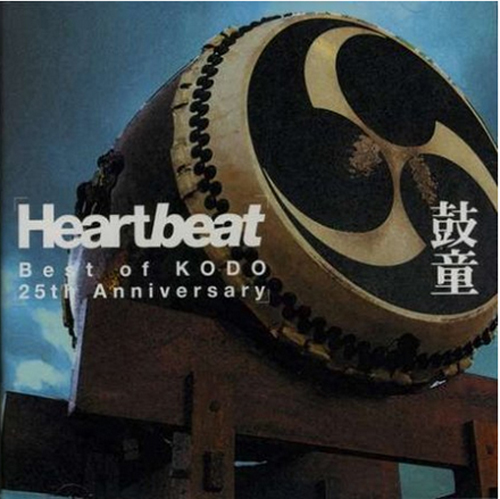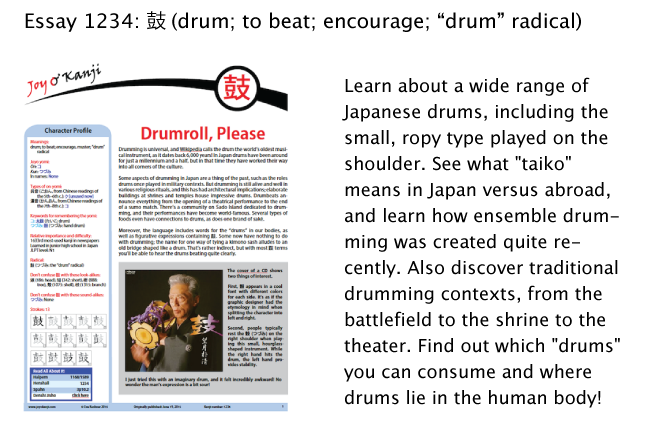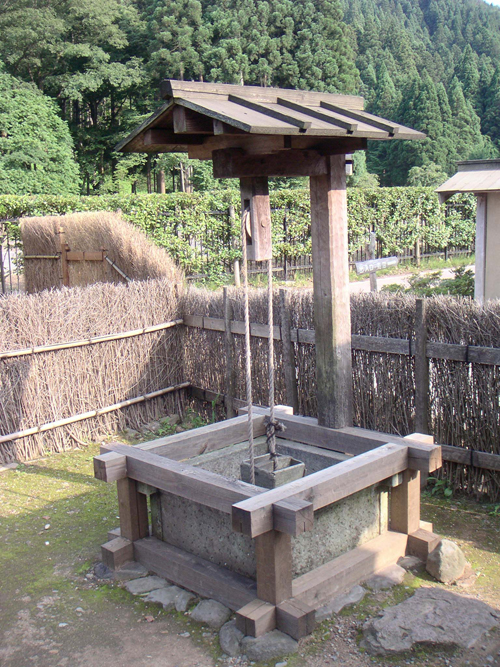Drawing on Shapes
If you saw the following phrase, would you know what to make of it?
立つ字輪鼓
I could break down the bits this way:
立つ (to stand up)
字 (character)
輪 (circle, wheel, ring)
鼓 (drum)
Did that help?! Well, let's see ... We have a character struggling to stand atop a round drum, so I'm going to have to go ahead and say no!
To understand this phrase you need to know two things:
1. The 立つ字 seems to refer to the hollowness of the kanji 立. The expression 立つ字 isn't one that native speakers use or even recognize immediately. My proofreader needed to research it to ascertain the meaning.
2. The 輪鼓 (りゅうご) primarily means "hourglass-shaped object." That's because the 鼓 (つづみ) is a small traditional hand drum with an hourglass shape.

You can buy this 鼓 on Amazon Japan.
Curiously, an alternate rendering for 輪鼓 (りゅうご: hourglass-shaped object) is 立鼓. It's just a coincidence that we're seeing 立 again!
I found 立つ字輪鼓 in an Amazon Japan product title for a pendant with a family crest. All together, then, 立つ字輪鼓 is an "An hourglass-shaped crest as hollow as the kanji 立."
The Japanese have plenty of kanji and words for "hollow." In fact, I did a round-up of such kanji in one JOK Notebook post. Why, then, would someone opt to represent "hollow" with 立? I don't know, but I find it charming and creative, and it made me wonder about similar uses of other kanji.
The topic feels so familiar that I wondered if I'd blogged about it before. All I could find was a post mentioning this word:
八の字髭 (はちのじひげ: mustache in the shape of a 八) 8 + character + mustache
The kanji 八 (eight) pops up in another blog in this word:
八文字 (はちもんじ: (in) the shape of the character 八)
Again we're seeing a reference to the shape of 八, rather than its meaning.
As the same blog says, the Japanese sometimes use 十 for its shape, as opposed to its meaning (ten):
十文字 (じゅうもんじ: cross (on a church); (Red) Cross)
It's clear that simple shapes such as 立, 八, and 十 lend themselves well to this appropriation. I imagine that 口 represents a square in a description somewhere, rather than having anything to do with a mouth or opening.
I'm sure I've encountered other examples, only they're escaping me now.... How frustrating!
Two of the simplest shapes I've written about do satisfy my strangely urgent new quest. One is 乙 (1041: second (in order or quality); strange; stylish), which people have used for its shape in a few ways:
• In the past (possibly only in China but maybe also in Japan), this proofreading mark instructed people to insert a missing character (as a caret does), invert a character, or make a paragraph indent. Here’s the term for that symbol:
乙字形 (おつじがた: “乙” mark) proofreading symbol + character + -shaped
• There's a plumbing pipe shaped like a 乙:
乙字形管金具 (おつじがたかんかなぐ: 乙-shaped pipe)
The other kanji that comes to mind is 井 (well), but it's only indirectly relevant. For instance, multiple sources (including Halpern and one question-and-answer website) theorize that the term 天井 (てんじょう: ceiling) includes a well because a typical Japanese ceiling includes repeating grid patterns. Although it would be wonderful to think that the ceiling mimics the shape of the kanji, that's not how it works. Instead, the kanji is the pictograph of the square frame atop a Chinese or Japanese well, the place where one would rest a bucket. In other words, the 井 grid represents this part of a well:
井桁 (いげた: well curb; well lining) well + beam
When referring to grid patterns in designs, the Japanese use 井桁 or terms with 井桁 at their roots, as in these examples:
井桁絣 (いげたかすり: splashed-pattern cloth with a well curb shape)
well curb shape (1st 2 kanji) + splash pattern (on cloth)
井桁紋 (いげたもん: crest with a well curb pattern)
well curb pattern (1st 2 kanji) + crest
The word 井桁 also applies to company logos, such as those of these major business groups:
• Sumitomo (住友, すみとも), whose logo is a rhomboid 井桁
• Mitsui (三井, みつい), whose logo is a circled rhombus that contains 三
Some businesspeople refer to these companies by their nicknames, which are based on the logos:
• Sumitomo’s nickname: 井桁
• Mitsui’s nickname: 丸に井桁, where 丸 (まる) means “circle”
To my surprise, the Japanese don't use 井桁 for the # symbol on a phone. Rather, they call this mark シャープ, a reference to the musical sharp sign. This シャープ can also mean the hashtag with which people mark keywords or categories in Twitter. As for the # in #1, people call that a ナンバー, but officially it’s a 番号記号 (ばんごうきごう: number sign).
Anyway, whenever the Japanese hear a word with 井桁 at its stem, they visualize a grid pattern, not an actual well curb, because wells are no longer part of daily life in Japan. Therefore, a kind of evolution has occurred. Even though those 井桁 terms don't directly reference the shape of the 井 kanji, it would make more sense to people if it did, rather than alluding to a well curb they've never seen. Perhaps 井 can soon join the ranks of my frustratingly small list of kanji whose shapes have inspired creative descriptions.
Just one more thing before I go. In writing the newest essay I learned about the non-Joyo kanji 巴 (ともえ), which represents apostrophe-shaped or comma-shaped designs on the skins of large Japanese drums. A pattern with a swirl of three 巴s—the so-called 三つ巴 (みつどもえ)—is particularly striking.

The cover of a CD by a famous ensemble drumming group.
Here's a sneak preview of the latest essay, which happens to mention drum-shaped benches:

Have a great weekend!


Comments